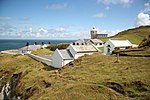Morte Point
Devon geography stubsHeadlands of DevonNational Trust properties in DevonTourist attractions in Devon

Morte Point is a peninsula on the north west coast of Devon, England, belonging to the National Trust. To the east is the village of Mortehoe and to the south is the seaside resort of Woolacombe. In the summer season, tractor and trailer rides are operated from the Mortehoe Heritage Centre onto the point for visitors to view the seals that live on the northern side.
Excerpt from the Wikipedia article Morte Point (License: CC BY-SA 3.0, Authors, Images).Morte Point
Mortehoe Station Road, North Devon Mortehoe
Geographical coordinates (GPS) Address Nearby Places Show on map
Geographical coordinates (GPS)
| Latitude | Longitude |
|---|---|
| N 51.188 ° | E -4.211 ° |
Address
Site of Coast Guard Lookout Point
Mortehoe Station Road
EX34 7DR North Devon, Mortehoe
England, United Kingdom
Open on Google Maps









